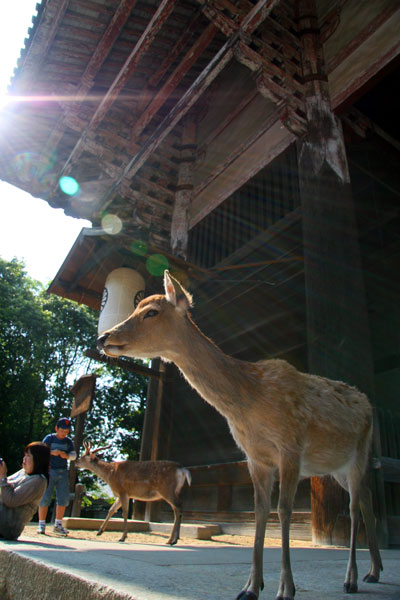
I've been wanting to write about the hidden beauty of Nara's old residential district, one of my favorite places in the Kansai region. But then I realized that:
i) Most readers probably plan to see Nara's World Heritage sites
ii) Some may not have time to do Nara in depth
Being your dutiful reporter, I will present my view of Nara's most well-known tourist attractions, all located within the Nara Park area which most people could cover in one afternoon. So if you're crunched for time, this article is for you. But if you like your vacation slow and thorough, you should also read the next article on my favorite side of Nara -- the Nara-machi town.

Although not my favorite part of the city, Nara's main sights are still exceptionally beautiful, and I cannot recommend that you skip any of them. Even if you have little background in Japanese culture or in Buddhism, you can just sit on the veranda of an ancient temple and watch rain drops gliding down the lanterns. When you consider the antiquity of this 1300-year-old former capital of Japan, everything around you takes on a certain timeless quality.

Again, you can easily do the main sights in Nara Park in a full afternoon, but I would recommend taking it slower and just absorb the historical atmosphere. In case you're wondering, these are not tombstones, but donation markers describing the names of the donors and the amounts of donation. The stone at the front marked a 1000-yen donation by a certain Mitsui-san, probably in the pre-2nd-World-War era. 1000 yen is like US$10 nowadays.
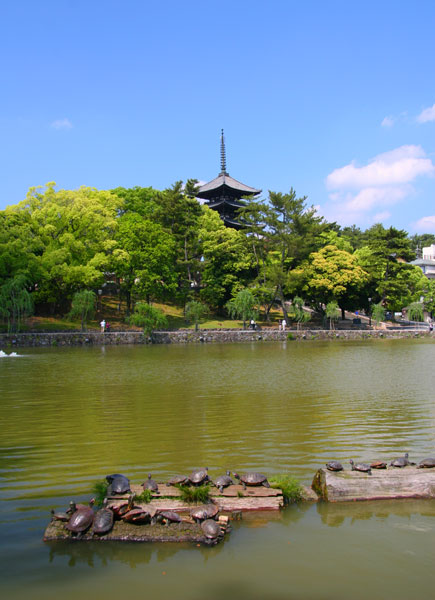
As you approach the Nara Park, the Sarusawa-no-Ike (literally "Monkey Swamp Pond") will probably be the first thing you come across ... besides the deer that is. The reflection of the Five-Storey-Pagoda on the pond is treasured as one of the famous traditional sights of Nara. No reflections on this windy day, but the turtles seem to be really enjoying the sun tan.
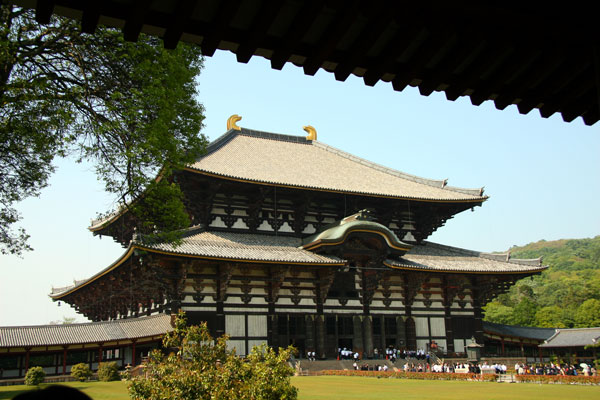
For most tourists the number one must-see attraction is the colossal Todaiji temple, the largest wooden building in the world prior to the 20th Century. You may not realize the massive scale of the temple from afar, until you compare it to the size of the minuscule people crowding at the bottom. But most people don't realize that today's Todaiji, dated 1691, is actually 30% smaller than its previous incarnation from the 12th Century.
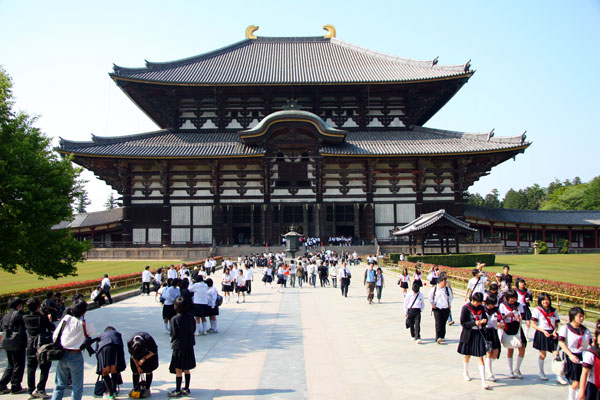
There's a Taj-Mahal-ish feel of grandiose as we approached the Todaiji from the front. We're now right in the middle of Nara's UNESCO World Heritage Site, and every major building or sculpture in the surroundings is invariably some sort of National Treasure of Japan. I hope the hordes of visiting high school students here appreciated the significance of their cultural heritage as much as tourists who had to fly here from halfway around the globe.
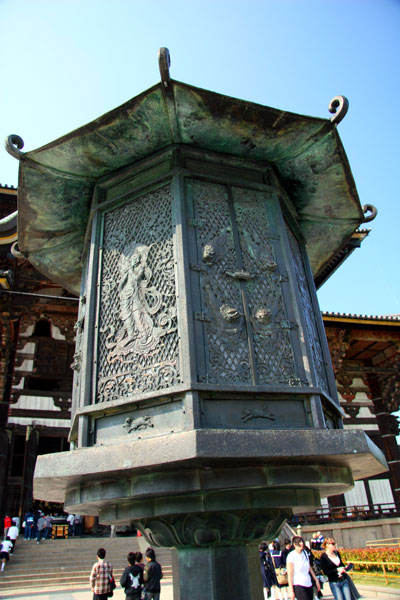
The bronze Octogonal Lantern in front of the Todaiji, dating from the 8th Century, is one of the National Treasures you'll see on the way to the temple's interior. Decorated with intricate relief carvings of flute-playing Bodhisattvas, the lantern's design closely resembles artifacts from the Tang Dynasty in China.
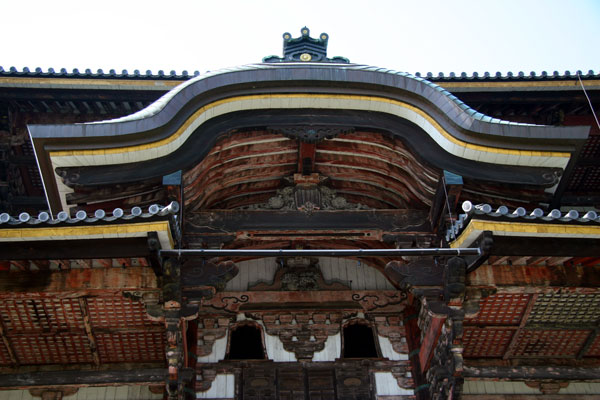
Interestingly when the 3rd incarnation of Todaiji was rebuilt 300 years ago, the architects decided to add this curved roofline known as Karahafu (Chinese Bargeboard), which has been a main feature in traditional Japanese architecture rather than in Chinese architecture. According to the scale models displayed inside the temple, the original and 2nd-generation Todaiji had straight rooflines. Though to the casual tourist, it is enough to see the fading paint on the aging wooden structure, and wonder how the architect managed to construct a masterpiece that would endure Japan's humid summers and frequent earthquakes for centuries.
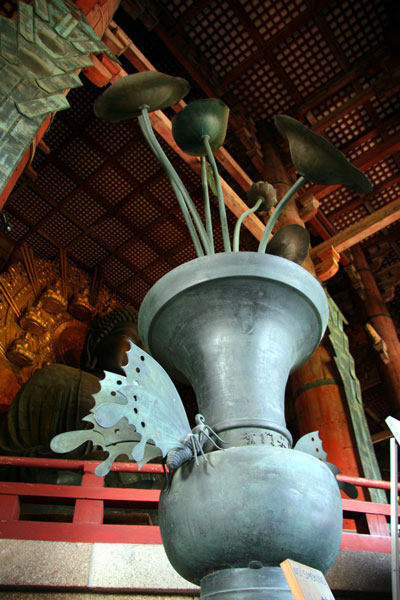
The huge bronze Lotus Vase inside the entrance. Ornamental butterflies decorate the sides of the vase while the lotus flowers reach for the sky.
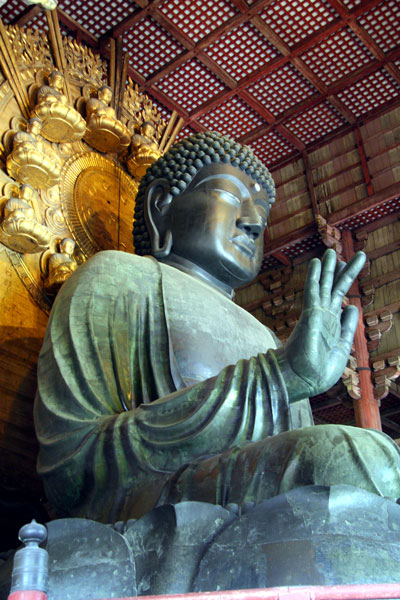
This is what most tourists have come to see -- a 15-metres-tall bronze Buddha dating mostly from the 8th Century. I said mostly since the head and the hands were recast in latter centuries due to various damages, but most of the statue was from the original casting. Now this was a major international endeavor back in the day, since the project was said to have consumed most of Japan's bronze and involved blessings from Buddhist priests from as far as China and India.
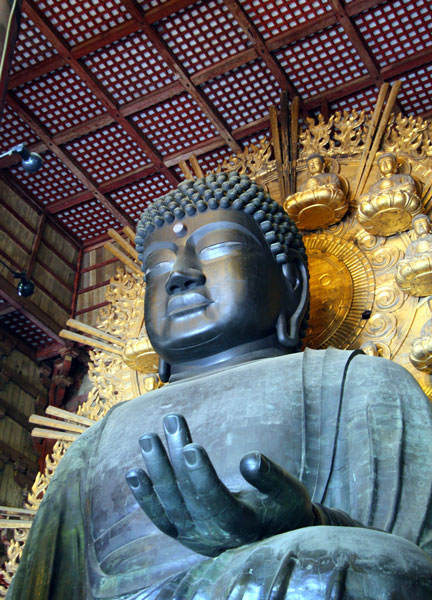
Now I have little knowledge on Buddhism beyond textbooks, but it doesn't require religious knowledge to understand what 500 tonnes of bronze would mean to the relative small scale of economy back in the 8th Century. This is somewhat akin to France's Chateau de Versailles, a monumental legacy created at the expense of almost bankrupting the nation's economy at the time.
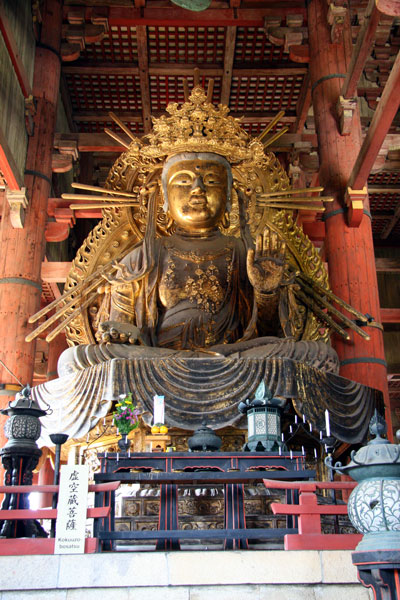
Aside from the main Buddha, there are scores of other statues such as this Kokuzo Bodhisattva, paling in historical (dated mid-18th Century) and artistic importance compared with the main Buddha but still aesthetically striking.
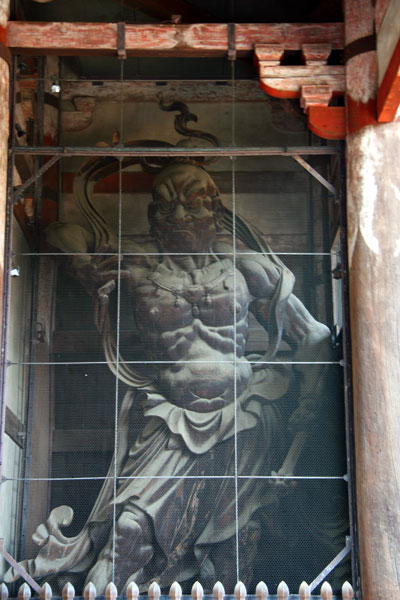
Then there are the wooden statues of the Guardian Warriors (Nio) from the 13th Century. If I remember correctly this one was located at the Nandaimon outside of the main hall.

Another Guardian Warrior -- this one is known as the Wide-Eyed Deity (Komoku-Ten). By the way, in case my pictures are giving you the impression of a quiet, hallowed sanctuary of worship, let me tell you that I had been rubbing elbows with hordes of rowdy, uniformed high school kids while taking these pictures. Your visit won't be as Zen-like as you may have hoped.
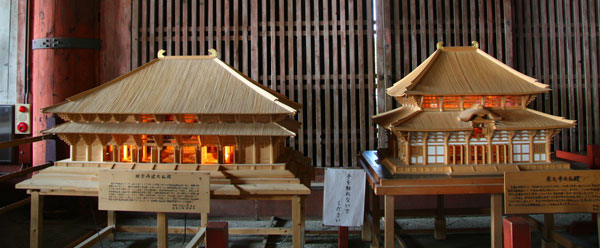
As I mentioned there was this scaled model of the three incarnations of Todaiji, and this photo shows the comparison between the 2nd generation temple (left) from the 12th Century and the current temple (right) dating from the 17th Century. As you can you the current temple is slightly taller and has a more intricate facade design with the curved bargeboard, but it also had shrunk 30% in terms of volume.
There was also a large souvenir stand inside the temple, and the prices were very reasonable (ie. little or no markup compared to the shops outside). This is a good place for souvenir shopping if you don't have time to properly tour the city.
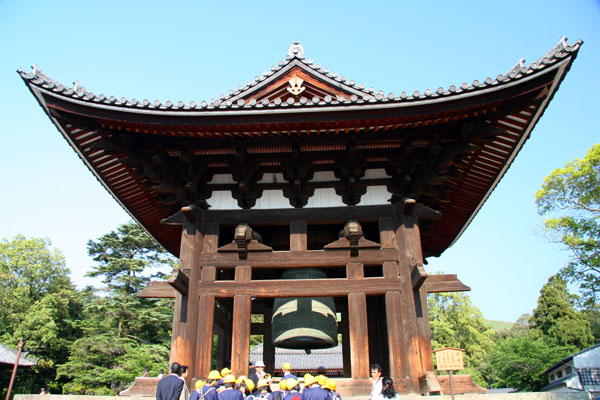
Whew...finally away from the tsunami of students rushing through the Todaiji temple. Well the students aren't going anywhere, but at least there's a little more space to appreciate the atmosphere with a little more tranquility. This bell tower is just east of Todaiji, and boasts probably the largest bell in Japan dating from the same period as the huge bronze Buddha. The economic impact of the project is looking more and more impressive.
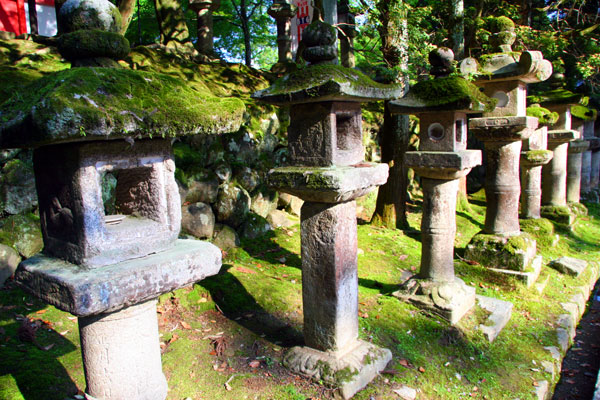
Rows of stone lanterns known as Joyato (literally Eternal Lanterns) decorate sections of the pathway leading towards the Kasuga Taisha, another temple included in Nara's World Heritage Site. Every mid-August (usually Aug 14-15) the Kasuga Taisha holds a festival where all of its 3000 lanterns are lit, so plan your trip accordingly if you wish to witness this event.

While walking around the Nara Park complex you'll run into shops selling Nara's famous pickled vegetables known as Nara-zuke, created by pickling cucumbers, melons, eggplants etc in fermentation residues from brewing Sake wine. Though most westerners don't like the sounds of it, I can assure you that it actually tastes much better than you may think. During my travels in Japan I hardly had a meal without some sort of "-zuke" pickles, and I almost invariably finished them all.
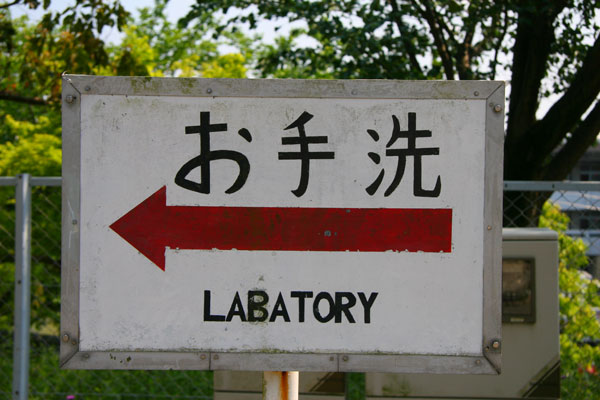
LABATORY? LABORATORY? Oh they mean LAVATORY! Now you know that the English sounds of "VA" and "BA" are translated to the same sound in Japanese (eg. Vancouver, where I live, is pronounced as Bankuubaa). So don't go to the LABATORY looking to fill some test tubes ...
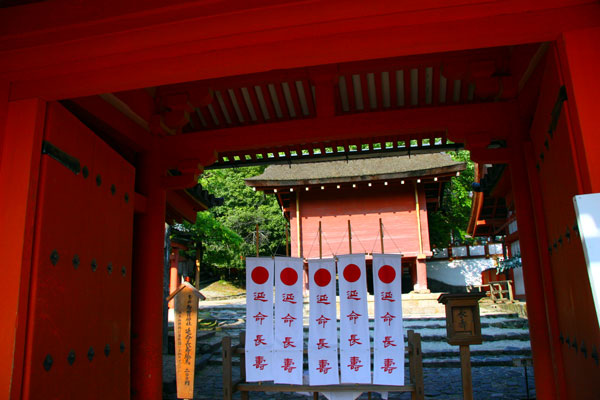
Bold red and white banners reading "Enmei Choju" (a prayer for longevity) grace this little shrine somewhere within the complex of the Kasuga Taisha. This is now in the middle of a *Shinto shrine*, as opposed to the *Buddhist temple* complex of Todaiji. Japan's two main religions have developed a complex symbiotic relationship over the past 1400 years, to the point that most Japanese are both Buddhists and Shintoists. You may have heard the saying that most Japanese are wed by a Shinto priest and buried by a Buddhist monk, which is still quite true.
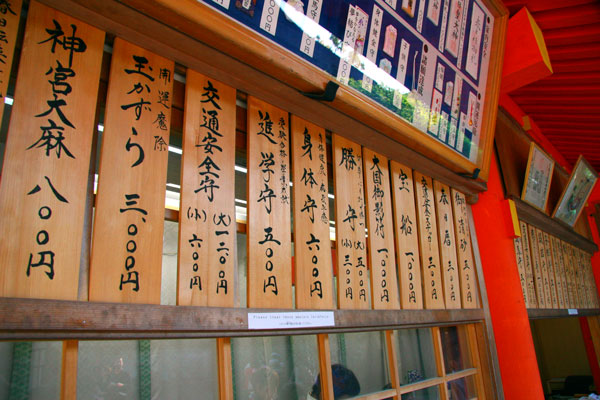
The more famous the shrine, the better likelihood of operating it as a hugely successful money making business. Being one of the nation's prominent Shinto shrines, Kasuga Taisha will charge anywhere from 300 yen (CAD$3) for a "Road Safety Sticker", to 500 yen (CAD$5) for an "Academic Study Amulet", to a whopping 3000 yen (CAD$30) for a "Tama Kazura" (literally Jade Vine) for "inducting fortunes and ridding evils". I have no idea what it is ... the only Tama Kazura that I know of is a species of plant. Please leave me a message at the bottom if you know.
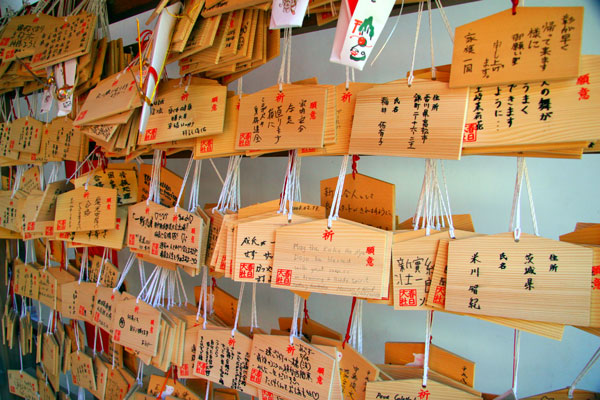
Some choose to write their wish-lists on a wooden plaque. One side for the wish, and the other side for sender's name and return address -- not a bad system to make sure the Shinto deities don't mix up the wishes.
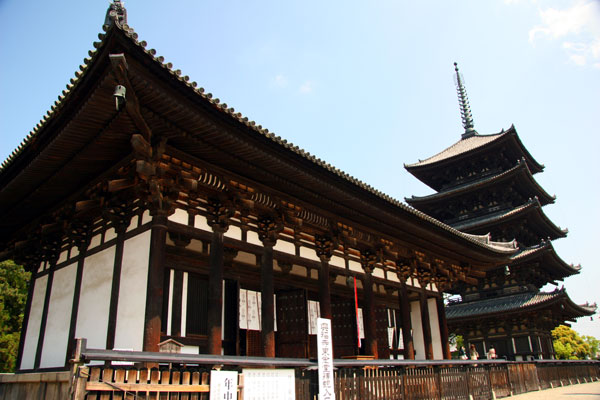
Back to the Five-Storey Pagoda and its surrounding Kofukuji temple, which is (surprise surprise) another World Heritage building. If you're starting to get tired of temples and shrines now ... didn't I tell you that my favorite part of Nara is SOMEWHERE ELSE?

This is what I will always remember of Nara Park -- large, dotted with beautiful ancient architecture, and infested... I mean blessed... with two things ...
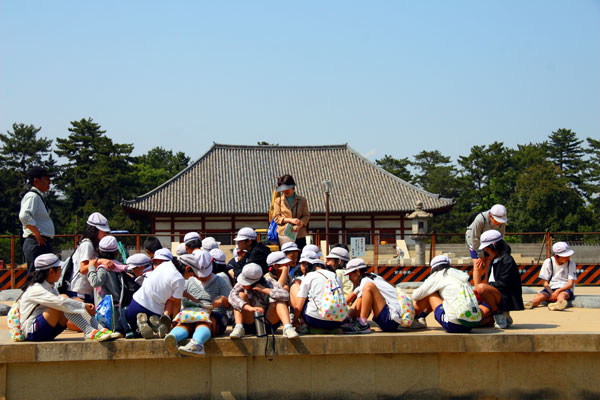
ONE -- hordes upon hordes of students, as we happened to be visiting during the school trip season of mid May. These elementary school kids here were at least controllable by their teachers, but the high school ones would *swarm* around all popular photo spots and pose endlessly, blocking all other tourists from taking clear shots. That was the price we paid for the pleasant weather.
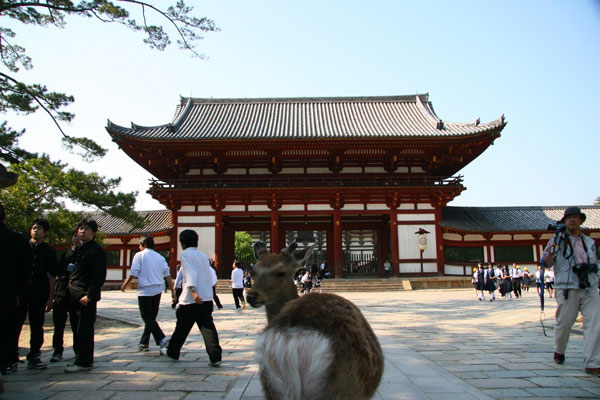
AND TWO -- the nickname of "Deer Park" isn't coined without reason. Though generally quite tame, the deers would mass around any unsuspecting tourist with any edible item in hand and snatch the food from the hands without invitation, as we've seen happening to Japanese and Western tourists on numerous occasions.

Inside Nara Park they are embraced as Shinroku, or Divine Deer, and you know it from the gaze in their proud eyes. I wouldn't recommend it, but if you're REALLY inclined to be assaulted by furry ruminants, pay up a couple hundred yen for some Deer Biscuits, and I can assure that you'll be very popular in no time.
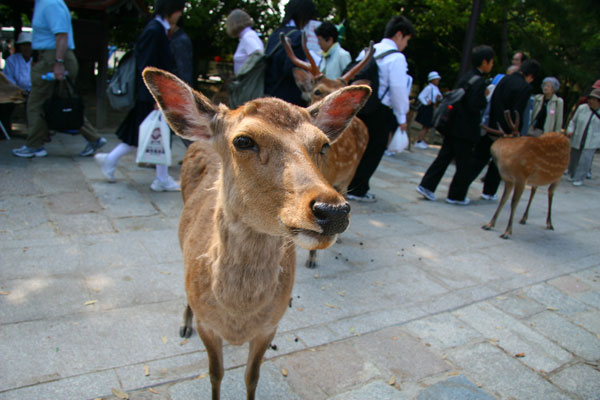
Come to think of it, the only people they don't attack are the Deer Biscuit vendors -- why don't they just attack the vendors, overturn their carts and grab all the biscuits? Hmm ... very fishy. I seriously suspect that the deer have some sort of insider deal with the vendors ...
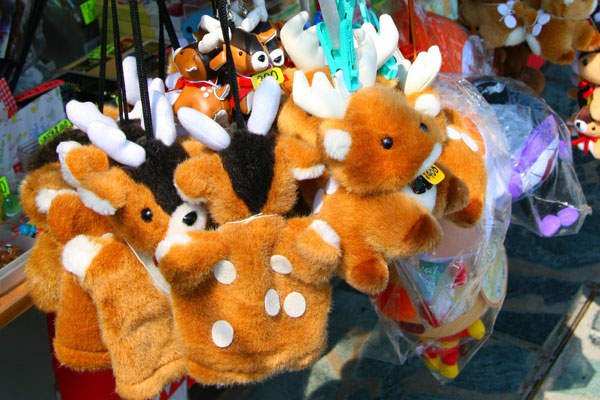
PRACTICAL INFORMATION
Transportation
Nara is served by two railway companies -- the national Japan Rail (JR), and the private Kintetsu railway. Being in the close vicinity of Osaka and Kyoto, many domestic and Western tourists will take a sidetrip to Nara while touring the Kansai region. From Kyoto or Osaka it should take roughly an hour and cost a few hundred yens, if you travel by cheap non-Express trains.
If you're coming from Osaka or Kyoto, it may be more convenient to take the Kintetsu since the Kintetsu Nara station is within walking distance of Nara Park. If you take the JR, then you probably want to take a local bus and save 20 minutes of walking to Nara Park upon exiting the JR Nara station. The Nara Park is a huge rambling place, and it's quite an uphill walk from the Todaiji to the Kasuga Taisha. We decided to walk uphill to Kasuga Taisha then took the bus back to the JR Nara station, but you can easily do the reverse -- taking the bus to the top and then make your way down. Ask for buses going to "Kasuga Taisha Honden", which are numbers 52, 63, 70, 88, and 97, at the time of writing (July 2008). Bus fares are currently 180 yen (CAD$1.8) per trip within central Nara, which includes Nara Park and the two train stations. Or ask for the day pass (say "Ichi-nichi Joshaken" to the driver) for 540 yen if you think you'll take three or more trips. As with most buses in Japan, you take a ticket from the little ticket-dispenser machine UPON BOARDING the bus, then show it to the driver upon disembarking.
Other Logistics
If you're on the way to somewhere and need a locker to store your luggage, there are lockers of several different sizes at both Kintetsu Nara and JR Nara train stations. The 500-yen (CAD$5) size was enough to stash one large and one small backpacks for us, but there are 600-yen ones which should be enough for 28-inch suitcases.
If you aren't picky about lunch, there are a few restaurants and Soba noodle houses scattered around the Nara Park. But for a wider range of choices (and more value for you money in general), you may want to read about the old town of Nara-machi in the next article.



No comments:
Post a Comment